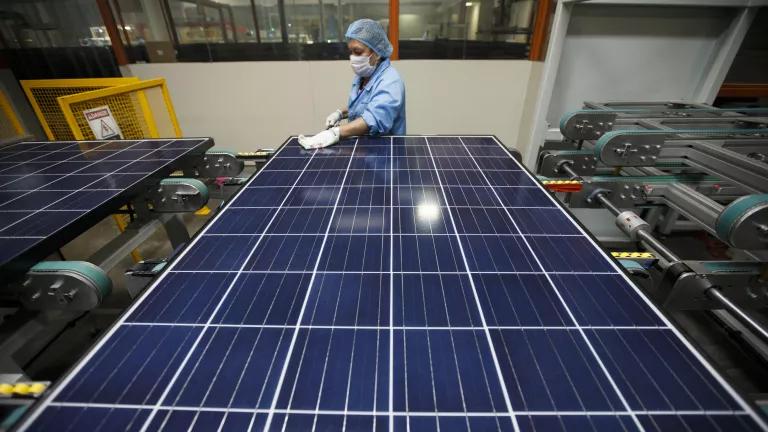Reduce Electric Industry Uncertainty to Speed Climate Action

America’s cities and states have continued to make tremendous progress to increase clean energy and reduce climate pollution despite the Trump Administration’s efforts to push in the opposite direction. And many utilities also have been leaders, largely because it makes good business sense. But policy-makers could help them to do even more by working harder to resolve the market and regulatory uncertainty surrounding this industry transition—a fact that becomes more clear in Utility Dive’s sixth annual utility sector survey.
In fact, uncertainty was the theme of the 2019 State of the Electric Utility Survey, which included responses from more than 600 U.S. and Canadian executives from investor-owned, municipal, and cooperative electric utilities.
On the one hand, the survey confirms that utilities do not expect to change course in their commitment to a cleaner energy future, something they have been saying consistently over the more than two years of federal government assault on clean energy and climate action. On the other, they are uncertain about future market and regulatory structures (how they buy and sell energy and meet customers’ needs), although they expect them to change dramatically. With one notable exception, the uncertainty extends even to the utilities’ own preferences. And this makes it more difficult to justify the types of long-term investments in the electric system that our clean energy transition requires.
Utility executives expect to stay the course on clean energy
Over the last several years, many utilities have retired or announced plans to retire their coal plants, and those decisions are not reversing or slowing down despite efforts at the federal level to push back. In fact, more than 80 percent of utility respondents to the survey think the federal government should regulate carbon pollution and only 4 percent support a federal bailout for coal and nuclear plants. Coal market share plummeted from more than 50 percent of our electricity in 2000—to less than 30 percent in 2017.
Utility plans for investing in clean energy have not flagged and expectations (their expectations) are that those efforts will continue and even increase. More than 80 percent of respondents from each region expect moderate or significant increases in utility-scale solar generation, distributed (or onsite) generation like rooftop and community solar panels, and energy storage.
Performance-based regulation is the preferred cost recovery method
While there is a wide-spread expectation that the way utilities are regulated will undergo a major transformation, there did not appear to be any consensus on what that model would, or even should, look like. The lack of consensus on the model is not particularly surprising given the diversity of approaches already used by our numerous state regulators and local utility boards, but uncertainty over how that structure will change has been rising in recent years—as has the level of utility anxiety surrounding it.
In fact, uncertainty over market conditions and regulations was identified as the greatest challenge to utilities’ changing generation mixes. For example, about a quarter of respondents were unsure about what kind of wholesale market they would be dealing with in 10 years, and that uncertainty also extended to state regulatory models.
Widespread agreement appeared only in the desire for more performance-based regulation, which makes part of a utility’s revenue contingent on meeting targets around metrics like customer satisfaction, reliability, or the ability of third-party providers to connect to their systems. This was true for both investor- and publicly-owned utilities, but Utility Dive noted that interest from the latter may be more reflective of a desire for enhanced performance standards within their organizations.
Interestingly, there was a low perceived importance placed on utility bill rate reform, with only 26 percent ranking it as a top concern facing industry, and only 11 percent as important in the future.
Staying the course, but how can we accelerate the pace?
While utilities are committed to their investments in the clean energy future, they did indicate that pervasive uncertainty about regulations and markets is making it harder for them to justify (to regulators, customers, and investors) some of the investments they consider necessary to get there.
Justifying emerging utility investments in things like storage, electric vehicle charging systems, and microgrids emerged as one of the top four regulatory challenges, along with revenue lost to energy efficiency and reduced electricity use. The latter can be addressed in large part through decoupling (an adjustment mechanism that makes utilities indifferent to how much energy they sell) and standards for efficient electrification from clean resources like wind and solar.
However, lack of clarity about whether and how a utility can invest in or enable these important technologies could mean that other providers of these services and technologies will step in to fill that gap (which can work as long as the utility has an incentive to facilitate these investments). But sometimes, as we’ve seen in the case of EV chargers in certain markets, nobody will invest because the business case isn’t there.
Key changes in how utilities are regulated, and in the markets where they operate, could significantly alter the way they do business and speed up the decarbonization of our energy system. Policy-makers at the state and federal levels need to step up the pace to resolve outstanding market and regulatory uncertainties in a way that allows utilities and all players in the market to make long-term investments in the electric system. NRDC stands ready to help.
When we allow uncertainty in these areas to linger too long, progress in transitioning to a clean energy future can be slowed. That’s the last thing we need right now.




